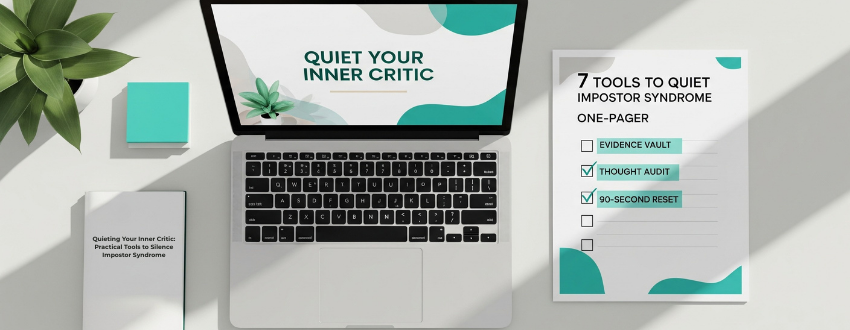Quieting Your Inner Critic: Practical Tools to Silence Impostor Syndrome

If you’ve ever thought, “Soon they’ll realize I’m not as capable as they think,” you’ve met the inner critic. For many high‑achieving women, that voice shows up as impostor syndrome at work—discounting wins, magnifying mistakes, and turning new opportunities into stress tests. Additionally, Research from Harvard Business Review shows that 70% of people experience impostor syndrome at some point in their careers.The good news is that with a practical impostor syndrome strategies toolkit, you can quiet that inner critic and build lasting confidence.
Furthermore, this comprehensive guide shares proven impostor syndrome strategies you can implement immediately to start overcoming self-doubt and lead with your brilliance—without waiting for permission.
Recognizing Impostor Syndrome at Work: Key Warning Signs for Your Strategy Toolkit
- Attribution flip: Credit luck or timing for success; own blame for any miss.
- Over-prep spiral: Triple the prep for routine tasks to avoid being “found out.”
- Hesitation tax: Delaying job applications, promotions, or speaking in meetings unless you feel 100% prepared.
- Visibility avoidance: Staying silent in meetings or avoiding leadership roles to escape judgment.
Additionally, these patterns often reinforce each other. Naming these patterns is step one. However, building a toolkit requires consistent practice. Step two is building a toolkit you can rely on when the inner critic gets loud.
7 Proven Impostor Syndrome Strategies: Your Complete Toolkit for Success
Strategy #1: The Evidence Vault (facts > feelings)
Moreover, the Evidence Vault serves as your confidence foundation. Create a living record of wins so you can enter high‑stakes moments with proof, not panic. Research from the National Academies Press confirms that performance accomplishments are the strongest and most durable determinant of self-confidence.
How to do it (10 minutes to start):
- First, open a document or sheet with three columns: Outcome → Your Contribution → Evidence/Metric.
- Next, add 10 wins from the past 12–18 months (projects shipped, KPIs moved, stakeholder praise).
- Then, before big meetings or reviews, skim your vault.
- Finally, establish a weekly habit: add one new win every Friday.
Consequently, you’ll enter high‑stakes moments with confidence rather than anxiety.
Template row: “Reduced churn 9% → Led cross‑functional save‑playbook rollout → Q2 churn 3.8% vs 4.2%.”
Strategy #2: The Two‑Column Thought Audit (coach > critic)
Similarly, the Two-Column Thought Audit challenges negative thinking patterns. This impostor syndrome strategy helps you replace automatic negative thoughts with evidence-based responses. When the voice says, “I’m not ready,” challenge it in writing.
Specifically, set up two columns:
- Critic: Write the exact thought: “I only got invited because they needed a woman on the panel.”
- Coach: Replace with facts and agency: “I’m here because I led two successful launches; I’ll prepare three stories that add value.”
Therefore, do this for 3–5 thoughts before a presentation, review, or interview. It takes 5 minutes and shifts your brain from fear to plan.
Strategy #3: The 90‑Second Reset (body > brain)
In contrast to overthinking, the 90-Second Reset focuses on physiology. You can’t out‑think a nervous system in overdrive. Therefore, use a quick physiological reset. According to the Mayo Clinic, controlled breathing techniques can quickly reduce stress hormones and activate your body’s relaxation response.
- Box breathing (4‑4‑4‑4): inhale 4, hold 4, exhale 4, hold 4 (repeat x4).
- Grounding scan: press feet into the floor, relax jaw/shoulders, slow exhale.
- Power posture: tall spine, open chest, eyes up (2 minutes).
Subsequently, pair this with one line you believe: “I’ve done hard things before; I can do this, too.”
Strategy #4: Pre-Performance Run-Up: A Proven Impostor Syndrome Strategy (reps > perfection)
Subsequently, the Pre-Performance Run-Up builds on this foundation. Among the most effective impostor syndrome strategies is building consistent pre-performance routines. Rather than last‑minute over‑prepping, replace it with a consistent, short routine you trust.
The 5‑minute run‑up:
- First, skim your Evidence Vault (1 min).
- Then, review 3 key points and 1 clear ask (2 min).
- Finally, do the 90‑Second Reset and your one‑line mantra (2 min).
Ultimately, consistency builds confidence. The routine becomes your safety rail.
Strategy #5: The Exposure Ladder (micro‑bravery > waiting)
Meanwhile, the Exposure Ladder creates progressive skill building. If you wait to feel 100% ready, you’ll wait forever. Instead, build micro‑steps that stretch, not snap. Harvard Health research on exposure therapy shows that gradual exposure is one of the most effective methods for building confidence and reducing anxiety.
Specifically, create a 4‑rung ladder toward a scary goal (e.g., speaking to 100+ people):
- R1: Share a point in your team meeting.
- R2: Present a 3‑slide update to your department.
- R3: Co‑present at the all‑hands.
- R4: Lead a 10‑minute segment solo.
Therefore, advance one rung per week. Courage first; competence follows.
Strategy #6: The Feedback Bank & Ally Loop (clear mirror > guessing)
Furthermore, the Feedback Bank provides objective reality checks. Impostor syndrome thrives in ambiguity. Therefore, ask for specific feedback and enlist allies. Research from the Center for Creative Leadership demonstrates that specific feedback is essential for professional development and confidence building.
- After significant work, specifically ask: “What’s one thing that worked? One I can improve?”
- Additionally, save verbatim praise in your Feedback Bank (a sub‑tab in the Evidence Vault).
- Ally loop: Ask a trusted peer/manager to amplify your contributions in meetings and emails—and do the same for them.
As a result, you’ll get calibrated reality checks and public validation that counters the critic’s story.
Strategy #7: The Visibility Habit (communication > assumption)
Finally, the Visibility Habit ensures your work gets recognized. Great work doesn’t always speak for itself—instead, you must give it a microphone. This visibility-focused approach is one of the most underutilized impostor syndrome strategies for career advancement.
- Specifically, send a monthly impact note to your manager/sponsor: three bullets, each with outcome + metric.
- Additionally, use claiming language without apology:
- “I led the segmentation model that lifted conversions 18%.”
- “I negotiated terms that cut vendor costs 12%.”
- Furthermore, in meetings, own your ideas and credit others explicitly. Visibility isn’t vanity; rather, it’s stewardship of your career.
Weekly Impostor Syndrome Strategies: A 20‑Minute Routine to Maintain Confidence
- Wins (5 min): First, dedicate 5 minutes to updating your Evidence Vault.
- Plan (5 min): Then, spend 5 minutes planning your next exposure‑ladder action for the week.
- Prepare (5 min): Subsequently, draft your monthly impact bullet (or ship it if it’s that week).
- People (5 min): Finally, request one micro‑feedback or set one ally amplification.
Ultimately, small reps create big compounding returns.This compact routine compounds into confidence and helps quiet impostor syndrome week after week
Supporting Impostor Syndrome Strategies: How Managers & Male Allies Can Help
- Credit out loud. Specifically, attach names to wins in meetings and group emails.
- Invite voices in. For example, say “Before we move on, I’d like to hear [Name]’s view.”
- Sponsor deliberately. Most importantly, put high‑potential women forward for visible work, then back them in rooms they aren’t in.
Ultimately, allies don’t just believe—they transfer belief through consistent action.
Keep going (next reads)
- Full Guide: 5 Strategies to Overcome Impostor Syndrome at Work
- For allies: Male Allyship 101: How Men in Leadership Can Champion Women’s Success
- Confidence: From Self‑Doubt to Self‑Assurance: How Early‑Career Women Can Build Confidence
Book & Community
These impostor syndrome strategies form the foundation of sustainable confidence building. If this was useful, you’ll love my new book Power Without Permission: Real Stories & Practical Tools to Quiet Impostor Syndrome and Lead with Your Brilliance.
→ Learn more / pre-order: leadersadapt.com/book
→ Join the LeadersAdapt Community: leadersadapt.com/community
1. What are the most effective impostor syndrome strategies?
The Evidence Vault, Exposure Ladder, and Visibility Habit combine mindset with measurable actions.
2. How do I apply impostor syndrome strategies at work?
Use a weekly routine: update wins, plan small risks, draft impact notes, and request feedback.
3. Can impostor syndrome be permanently overcome?
It may not fully disappear, but consistent practice greatly reduces its effect.
4. What triggers impostor syndrome most often?
Leadership promotions, performance reviews, and male-dominated environments.
5. How can managers help employees struggling with impostor syndrome?
By giving credit, inviting input, and sponsoring visible opportunities.
YOUR JOURNEY STARTS TODAY
Isn’t it time you had an advisory team that truly elevates you!

I’m an executive advisor and keynote speaker—but before all that, I was a tech CEO who learned leadership the hard way. For 16+ years I built companies from scratch, scaled teams across three continents, and navigated the collision of startup chaos and enterprise expectations.